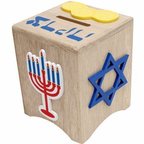
It’s time to include our kids.
I know they’ll be excited about dropping coins into our tzedakah box; my 2-year-old loves to gather “monies” in her little pink purse. Teaching little ones how to give tzedakah is important; we can fill up the tzedakah box, bring cans to the local food bank or donate unused toys to a charity for children in need. But instilling the values behind charity—the why of tzedakah—can be a bit trickier (especially with younger kids), even though it’s really important. Here are some ideas to get you and your family started.
Focus on basic values, such as gratitude and empathy. You can teach your children these ideas in small ways, in daily conversations. When my daughters ask for yet another baby doll, instead of just saying no, I try to talk to them about how it’s OK to want new toys, but also how lucky we are to have the dolls and toys we do have. (This doesn’t always work, and sometimes the conversation just devolves to, “No, we’re not getting another one, so stop asking,” but it’s important to keep trying.) When the girls are having a hard time sharing, I try to help them remember how it feels to want a toy and not have one, and how nice it was when someone shared with them. Now, these are big ideas, the children are young, and it takes time. It’s about planting seeds and watering them bit by bit, over time.
Stick to age-appropriate concepts. A few months ago, my older daughter told me she wanted to live in a bigger house. I tried to talk to her about how lucky we are to have a safe, clean home of our own. Then the social worker in me took over, and I couldn’t help but talk about how some families don’t have houses, and have to live in their cars. My daughter had a hard time understanding this and lost interest in the conversation. (I suppose that’s better than the alternative—I could have really freaked her out and spent days processing the idea of sleeping in a car, reassuring her that we won’t be sleeping in our car.) I learned my lesson, though. The girls aren’t ready to hear about major world problems—we’ll get there soon enough. So we talk about things they can relate to—that some people have bigger houses, some people have smaller houses, and yes, our house is small, but it’s also enough for us.
Model tzedakah, generosity and sharing, even in small ways. I’m not going to talk to my daughters about donating to our local public radio station or children’s hospital; they don’t yet understand money in that way. But they do understand when I share the last bites of my brownie or ice cream with them, when I make space for them on the couch, or when I let them have the big pink dreidel, even though I may have wanted it. Even if they can’t articulate it yet, they are starting to understand what it feels like to have someone else be aware of their needs, and to care enough to try to help.
Read books about tzedakah. It can be easier to grasp big concepts when they come in the form of stories, but I don’t often have the energy or creativity to come up with them myself. If you’re not already a member of the PJ Library, you should join—it’s a great source of free books for Jewish families. We’ve been reading “Say Hello, Lily” lately; while it’s not exactly about charitable giving, the backdrop of the story (a little girl goes with her mother to volunteer at an assisted living facility) is relevant. (There are also several great options on Amazon.com.)
In the meantime, I’m going to find some tzedakah boxes for the girls. I like these by Betsy Teutsch, or these by KidKraft. Or maybe we’ll even make our own. What ideas do you have? How do you teach your children about tzedakah?


